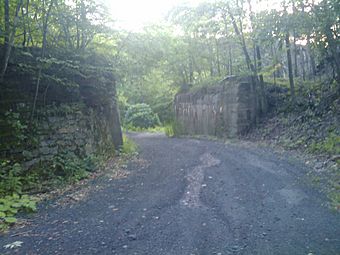Ashley Planes facts for kids
Quick facts for kids |
|
|
Ashley Planes
|
|

Abutments from the Ashley Planes in 2009
|
|
| Location | Off Pennsylvania Route 309, Fairview Township and Hanover Township, Pennsylvania |
|---|---|
| Area | 160.3 acres (64.9 ha) |
| Built | 1837, 1860s, 1909 |
| Built by | Douglas, Edwin A.; LC&N. |
| NRHP reference No. | 80003562 |
| Added to NRHP | January 25, 1980 |
The Ashley Planes was a special kind of cable railroad in Pennsylvania. It had three separate sections, each with its own power source. This railway connected the town of Ashley, Pennsylvania at the bottom to Mountain Top, which was over 1,000 feet (300 meters) higher.
It was first built between 1837 and 1838 by a company called Lehigh Coal & Navigation Company (LC&N). The Ashley Planes helped move goods, especially coal, across a tricky part of the land.
What Were the Ashley Planes?
The Ashley Planes was like a giant outdoor elevator for trains. Its main job was to connect two different railroad lines at different heights. It helped bridge the gap between the Susquehanna Valley and the Lehigh/Delaware valleys. This area was a "drainage divide," meaning water on one side flowed to one river, and water on the other side flowed to a different river.
Why Were They Built?
In the 1830s, trains were not very powerful. So, people used canals and rivers to move heavy goods like coal. The Ashley Planes was built to connect two important canal systems: the Pennsylvania Canal System and the Lehigh Canal. This connection was super important. It linked the coal-rich areas of Pennsylvania to big cities on the East Coast, like Philadelphia. It also helped connect the East Coast to newer settlements in the Midwest.
Coal was a vital fuel for factories and homes. But getting coal from the mines in Northern Pennsylvania to the cities was hard. Before the Ashley Planes, coal might have to travel by pack mule or long, difficult routes. The Planes made it much easier and faster to move large amounts of coal.
The railway was part of a bigger plan to improve transportation across Pennsylvania. It was built in 1837–1838 by the Lehigh Coal & Navigation Company in Luzerne County, Pennsylvania. It worked with new rail lines and an extension of the Lehigh Canal.
How Did the Ashley Planes Work?
The Ashley Planes had three sections, each with its own engine house. These sections worked like a funicular railroad or a cable railroad. This means they used a continuous cable, similar to how a modern ski lift works.
A special cart called a 'barney' would push the freight cars up the incline. The barney was hooked into the moving cable. An operator controlled the system using a winch, clutch, and brake. When a car reached the top of a section, the barney would drop away, letting gravity move the cars to the next part of the railway or to a marshaling yard (a place where train cars are sorted).
In its early years, the railway could also send cars downhill. This was useful for returning empty cars to the bottom. The tracks would split in the middle, allowing cars going up and down to pass each other.
These special railway sections were used to transport anthracite coal. They were in operation for a long time, finally closing in 1948. The Ashley Planes was added to the National Register of Historic Places in 1980, recognizing its importance in history.



